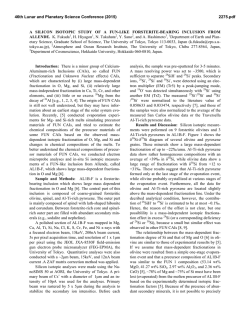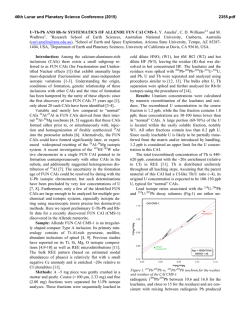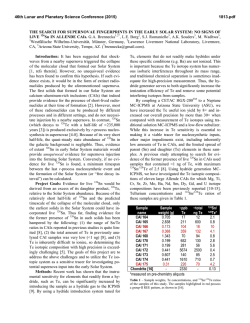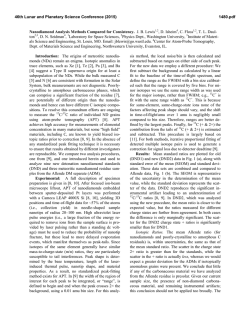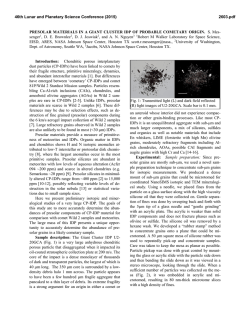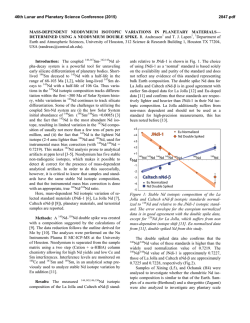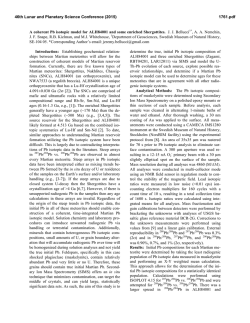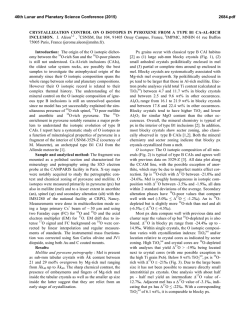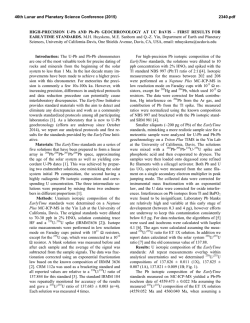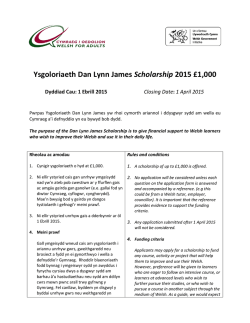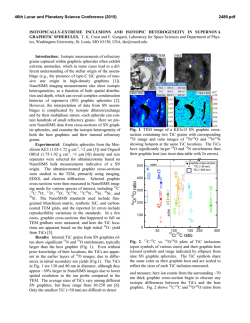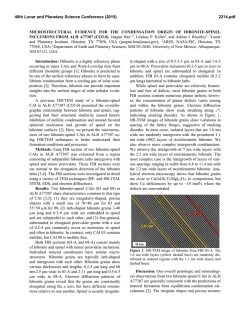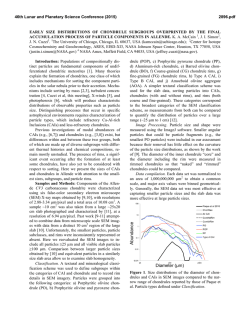
Chromium and Titanium Isotope Systematics of Allende CAIs
46th Lunar and Planetary Science Conference (2015) 2920.pdf CHROMIUM AND TITANIUM ISOTOPE SYSTEMATICS OF ALLENDE CAIs. C. M. Mercer1, A. K. Souders1, S. J. Romaniello1, C. D. Williams2, G. A. Brennecka3, and M. Wadhwa1, 1Center for Meteorite Studies, School of Earth and Space Exploration, Arizona State University, Tempe, AZ 85287, USA ([email protected]), 2University of California Davis, Davis, CA, USA, 3Institut für Planetologie, Westfälische Wilhelms-Universität, Münster, Germany. ples were introduced into the mass spectrometer using an Elemental Scientific Apex-Q with a 50 µL/min flow rate. A 2 ppm Ti solution yielded a 48Ti signal of ~16 V. We used a dynamic Faraday cup configuration to measure the intensities of 44Ca, 46Ti, 47Ti, 48Ti, and 49Ti before switching the magnet to measure 47Ti, 49Ti, 50Ti, 51 V, and 52Cr. Signals for 44Ca, 51V, and 52Cr were used to correct for isobaric interferences. Ti isotopic data are reported relative to an in-house SPEX Ti standard after internal normalization to 49Ti/47Ti (=0.749766 [22]) using an exponential fractionation law. 0.4 A NBS 979 ε53 C r 0.2 Allende 0.0 −0.2 SPEX Cr DTS −0.4 1.0 0.8 0.6 ε54 C r Introduction: As the first-formed solids in the Solar System (SS), calcium-aluminum-rich inclusions (CAIs) can preserve evidence for the original isotopic heterogeneity of the solar nebula ([1] and references therein). Certain isotopic patterns are considered to reflect nucleosynthetic components [2]. In particular, isotopic anomalies in the vicinity of the Fe-peak are potentially highly diagnostic for constraining the nucleosynthetic components produced in an r-process environment (e.g., [3]). These anomalies may help elucidate how and when presolar components, and possibly late-injection supernova (SN; plural: SNe) materials, were homogenized in the early SS, providing constraints on SS formation models (e.g., [4, 5]). We report Ti and Cr isotopic data for six Allende CAIs to contribute to a growing, multi-element isotopic dataset that currently includes measurements of Mg, Sr, Zr, Mo, Te, Ba, Nd, Sm, Gd, Dy, and U on the same set of eleven CAIs [6-11]. Titanium has five stable isotopes (46Ti, 47Ti, 48Ti, 49 Ti and 50Ti) while chromium has four stable isotopes 50 ( Cr, 52Cr, 53Cr and 54Cr) that are synthesized by distinct processes during hydrostatic and explosive nucleosynthesis in stars [12]. Also, 53Cr is produced by radioactive decay of 53Mn (t1/2 = 3.7 Ma). Here we focus on the neutron-rich isotopes 50Ti and 54Cr, which are thought to be produced primarily by r-process nucleosynthesis in either: (1) Type Ia SNe of white dwarf stars near the Chandrasekhar mass that have neutronrich, low-entropy conditions (e.g., [12-14]), or (2) Type II SNe (which additionally provide O-rich environments for the condensation of refractory oxides that carry 54Cr [14-16]). Compared to younger SS objects, CAIs have positive r-process anomalies in nuclides with A < 140 (including 54Cr, [17-20]), and negative r-process anomalies in nuclides with A > 140 [7]. This implies that SS materials incorporated r-process nuclides from multiple stellar sources, and that SN material was injected into a reservoir that was unsampled by CAIs [7]. We explore how the Ti and Cr isotopic compositions of Allende CAIs can refine our understanding of nucleosynthetic components in the early SS. Analytical Methods: Ti was purified by ionexchange chromatography following [21]. Ti isotopic data were acquired with a Thermo Finnigan Neptune MC-ICP-MS operated in high resolution mode (M/ΔM > 9000) at Arizona State University (ASU). The sam- 0.4 0.2 B Allende NBS 979 DTS 0.0 −0.2 −0.4 SPEX Cr Fig. 1. Long-term reproducibility of non-mass dependent effects (in ε units) in (A) 53Cr/52Cr and (B) 54Cr/52Cr for NBS 979, SPEX Cr, DTS rock standard, and Allende whole-rock. Each data point represents the average (±2SE) of 3-6 repeat measurements that utilized a total of ~1 µg Cr. All unknown analyses are conducted similarly (n = 3-6, total Cr consumed ~1 µg). The dashed lines bound the 2SD envelope for the average value of terrestrial synthetic Cr and rock standards. Cr was purified by an ion-exchange chromatography procedure modified from [23]. Cr isotopic data were acquired with the Neptune at ASU using an ApexQ and 50 µL/min nebulizer. An 800 ppb Cr solution resulted in a 52Cr signal of ~30 V. Measurements were done in high resolution mode to avoid polyatomic interferences [24]. The intensities of 50Cr, 52Cr, 53Cr, and 54 Cr were measured, along with 49Ti, 51V, and 56Fe to monitor and correct for isobaric interferences. Cr isotopic data are reported relative to the NBS 979 standard after internal normalization to 50Cr/52Cr (=0.051859 [25]) using an exponential fractionation 46th Lunar and Planetary Science Conference (2015) law. Our emperical external reproducibility is ±0.04 (2SD) for ε53Cr and ±0.08 (2SD) for ε54Cr from measurements of terrestrial synthetic Cr and whole-rock standards (Fig. 1), similar to theoretical limits of ±0.05 and ±0.10, respectively. Initial Results: We have measured the Ti and Cr isotopic compositions of 6 of the 11 Allende CAIs studied by [6-11], including CAIs 165, 166, 167, 168, 173, and 175. Values for ε53Cr range from -0.71 to 0.11, and ε54Cr ranges from 3.42 to 5.89 (blue symbols in Fig. 2). Some of the variation in ε53Cr is due to the presence of radiogenic 53Cr from the decay of 53Mn, so we have subtracted an estimated radiogenic 53Cr component using the initial SS 53Mn/55Mn value of (6.28 ± 0.66) × 10-6 [26] and the 55Mn/52Cr ratios measured in these samples (red symbols in Fig. 2). Values for ε50Ti range from 8.55 to 9.59 (Fig. 3). 2920.pdf these samples, while other elements (e.g., Ti, Sr, Mo, Nd, Sm, Gd, Dy) tend to have much smaller matrix/CAI concentration ratios (e.g., 0.6–1). It is plausible that the variation that we observe in ε54Cr could be due to addition of Cr to the CAIs from their host matrix (either by diffusion exchange with, or physical addition of, the matrix). A simple two-component mixture model of these two materials (Fig. 3) is consistent with this possibility, and implies that up to ~10% of the Cr in our samples could have originated from the meteorite matrix. If this is the case, then the highest ε54Cr values in CAIs may only constrain the minimum ε54Cr composition of the reservoir from which CAIs formed. This possibility should be considered when relating ε54Cr excesses to potential nucleosynthetic components in the SS. Fig. 2. Chromium isotopic compositions of Allende CAIs from this work before (blue circles) and after (red circles) correction for the presence of radiogenic 53Cr from decay of 53 Mn; errors are either the 2SD external reproducibility (Fig. 1) based on terrestrial standards or the 2SE internal errors based on 3-6 repeats of sample analyses, whichever is larger. Previous literature data for CAIs from Vigarano and Allende are shown for reference (grey circles, not corrected for radiogenic 53Cr) [17-20, 26]. Fig. 3. Plot of ε50Ti vs. ε54Cr for several achondrites, chondrites, and CAIs reported by [5], along with our data shown in red. Grey and blue dashed lines represent mixtures of Ti and Cr between CAIs (5400 ppm Ti, 200 ppm Cr; ε50Ti = 9.5, ε54Cr = 7) and CAI-free matrix material (2646 ppm Ti, 458 ppm Cr; grey: ε50Ti = 1.87, ε54Cr = 1.57; blue: ε50Ti = 0.68, ε54Cr = 0.63), with labels indicating the percentage of matrix in the mixture. Figure and model parameters after [5]. Discussion: The Cr isotopic data presented here and reported previously for Allende CAIs [17-19, 26], demonstrate variations in ε53Cr and ε54Cr that significantly exceed the precision of the measurements, while ε50Ti values show a much more restricted range (Figs. 2 and 3). While it is possible that the observed variation in ε54Cr reflects CAI formation in an inhomogeneous reservoir, we cannot rule out other potential causes (especially since ε50Ti does not vary significantly). Interestingly, other stable isotope systems measured for this sample set (Sr, Zr, Mo, Ba, Nd, Sm, Gd, Dy) indicate the CAI reservoir was nearly homogeneous (within the precision of the analyses) [6-11]. Note that the concentration ratio [Cr]matrix/[Cr]CAI is ~10 (using CI chrondrites as a proxy for CAI-free matrix, [5]) for References: [1] MacPherson (2014), Treatise in Geochemsitry (2nd Ed.), p. 139. [2] Meyer and Zinner in Meteorites and the Early Solar System II, (UofA Press, 2006). [3] Jungck et al. (1984) GCA, 48, p. 2651. [4] Rotaru et al. (1992) Nature, 358, 465. [5] Trinquier et al. (2009) Science, 324, p. 374. [6] Brennecka et al. (2010) Science, 327, p. 449. [7] Brennecka et al. (2013) PNAS, 110, 17241. [8] Mane et al. (2014) LPSC 45, #1685. [9] Mane et al. (2014) MetSoc, #5403. [10] Brennecka et al. (2014) LPSC 45, #2280. [11] Brennecka et al. (this meeting). [12] Clayton (Cambridge U Press, 2003), p. 218. [13] Woosley and Heger (2002) Rev. Mod. Phys, 74, p. 1015. [14] Wang et al. (2011) Astrophys J, 739, L58. [15] Dauphas et al. (2010) Astrophys J, 720, p. 1577. [16] Qin et al. (2011) GCA, 75, p. 629. [17] Birck and Allègre (1984) GRL, 11, p. 943. [18] Birck and Allègre (1985) GRL, 12, p. 745. [19] Birck and Lugmair (1988) EPSL, 90, p. 131. [20] Loss et al. (1994) Astrophys J, 436, L193. [21] Zhang et al. (2011) J Anal Atom Spect, 26, p. 2197. [22] Niederer et al. (1981) GCA, 45, p. 1017. [23] Yamakawa et al. (2009) Anal. Chem, 81, p. 9787. [24] Schoenberg et al. (2008) Chem Geol, 249, p. 294. [25] Shields et al. (1966) J. Res. Nat. Bur. Stand, 70A, p. 193. [26] Trinquier et al. (2008) GCA, 72, p. 5146.
© Copyright 2025
